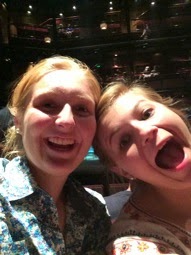In the midst of The Crucible by Arthur Miller is the feeling of fear and
insecurity. The entire town is enslaved to the idea put forth by one small
group, and it escalates into something much larger. Although the text and
acting conveys this idea well enough on its own, the set and scene transitions played
a large part in creating the eerie atmosphere of the town and of the idea of
uncertainty.
As the audience filed into the
theatre, the most obvious thing about the set to me was the fog. The fog machines
were on for a good portion of the half-hour before the play began, and the fog itself
was kept just thin enough to be able to see through it, but thick enough for it
to be noticeably there. By the time the intermission rolled around, most of it
had dissipated, but the machines started up again and kept the fog for the
first scene of the second act. In literature, fog is often used as a metaphor
for something that is unclear, and as the play centers on the question of
whether the girls of Salem are telling the truth, it was a very telling
introduction before any of the actors even stepped onto the stage. Even the
thickness of the fog was a clue: it was clear enough for the truth to be
visible, but it was still just dense enough for one to argue that the opposite
might be true. This reminded me of how the girls of Salem pull the wool over
the men’s eyes as they continue their act to get Goody Proctor, John Proctor,
and a large number of others killed. The men had multiple opportunities to see
what was really going on, especially when John Proctor
presented his case to the court, but they chose not to and instead continued
listening to the girls.
The set and stage itself also added
to the feeling of insecurity. The stage elements were all painted gray, and
there were some pieces of gray cloth hung precariously on some of the taller
parts of the stage. The color gray itself is an ambiguous color; it is not as
straightforward as black or white and lands somewhere in between the two. Many
of the townspeople do the same. They don’t want to believe that there is
witchcraft in their town, but they also don’t have another explanation for what
has been happening there. Also, the elements of the stage were in less than
pristine condition. Although they had been painted, the wood was rough, and the
pieces of cloth reminded me of dust covers on furniture from an attic that
hadn’t been explored in years. The old feel compares to the townspeople, who
are somewhat set in their ways, but it also contrasts to the new ideas of witch
hunts that were gaining popularity in Europe. Whereas their religion is an old
one, the idea of witch hunting is new and exciting to them and seems to be the
perfect solution to their problem. In addition, the play was done in the round,
so there were audience members on all sides of the stage. Because of this, I
felt as though I was actually a member of the Salem community and had to decide
for myself whether the “witches” were really witches at all. It felt as though
we, not the actors, were the council deciding their fate, and I definitely felt
the uncertainty that the townspeople must be going through.
The transitions between scenes added
to the insecurity of the town, as well. When the set needed changing, the
entire cast walked out and slowly carried the props and furniture off the
stage. The light was similar to that of the fog; it was bright enough to see
what was going on, but dark enough to keep it from being the center of
attention. The strangeness of it, however, was the way that the props were
carried off. The cast that wasn’t on stage during the previous scene walked in,
looking straight forward, and synchronously lifted whatever prop they were
assigned to. Then, all together, they turned toward the exit and carried them
off stage. This not only tells about the way the community works, but also
about how uncertain they may be. The synchronized walking is obviously used to
represent how the town works together and functions as a community; they know
what they are required to do, and they do it the same way everyone else does.
If any of them have any question about the events that are happening, they
don’t show it. Although some members of the community might have doubts about
the witch hunting, they still go along with it, because to disagree might mean
to be accused of witchcraft themselves. They are trying to return their daily
lives to the way they used to be before the “witchcraft” started.
The
Crucible shows how a community can be overtaken by uncertainty and the
desire to solve a problem, even if the townspeople aren’t sure that they agree
with the solution. I felt as though I were in the middle of the decision making
and that the fog was clouding my vision as it did to the men on the council in
an attempt to keep daily life as normal as possible. The set and transitions
demonstrate this without the actors needing to speak a word, and they add
another layer to the already complex functions of the town and the feelings of
the townspeople.










